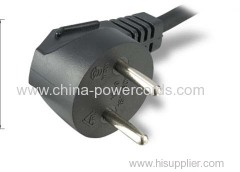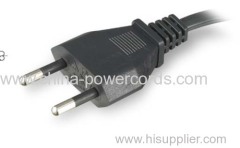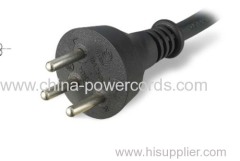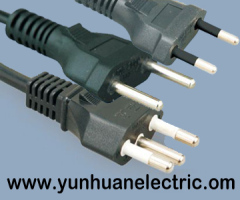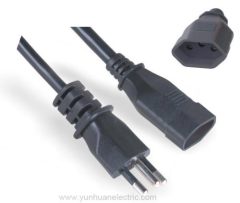
|
NINGBO YUNHUAN ELECTRIC GROUP CO.,LTD
|
Brazil Power Supply Cable UC Inmetro Approved
| Price: | 0.2~2.0 USD |
| Payment Terms: | T/T,D/A |
| Place of Origin: | Zhejiang, China (Mainland) |
|
|
|
| Add to My Favorites | |
| HiSupplier Escrow |
Product Detail
Brazil Power Cord products with InMetro certification are manufactured to the latest NBR 14136 and IEC standards including the IEC 60906-1 plug.
Brazil NBR 14136 Power Cord,Plug,Flexible Cable Standard
Brazil, which had been using mostly Class II Euro plugs, and NEMA 1–15 and NEMA 5–15 standards, adopted a modified (non-compliant) version of IEC 60906-1 as the national standard in 1998 (revised in 2002) under specification NBR 14136.[32] There are two types of sockets and plugs in NBR 14136: one for 10 A, with a 4 mm pin diameter, and another for 20 A, with a 4.8 mm pin diameter, the latter used for heavier appliances such as microwave ovens.[33] NBR 14136 was not enforced or encouraged in that country until 2007, when its adoption was made optional for manufacturers, becoming compulsory on January 1, 2010. It helped domestic consumers that most of Class II plugs fitted in the new NBR 14136 sockets.
Contents
1 . Plug Guide
2 . 10 Amp Power Plug
3 . 127 Volt / 230 Volt
4 . 60 Hz
5 . Power Cords
6 . Extension Cords
7 . Flexible Cables
8 . Certification
9 . Reference
Plug Guide
Left type N socket and plug are the official standard in Brazil. Type N consists of two pins and a grounding pin. There are two variants: the prongs of the 10 A version have a diameter of 4 mm and a length of 19 mm. The second version, rated at 20 amps, is used for heavier appliances and has 4.8 mm round pins, but also measuring 19 mm in length. The centres of the line and neutral pins are spaced 19 mm apart. The center-to-center distance between the earth pin and the middle of the imaginary line connecting the two power pins is 3 mm. Type N sockets were specifically designed to accommodate the ubiquitous type C plugs as well. Type N looks very much like the Swiss type J standard, but it is incompatible with it since type N has the earth pin closer to the center line than type J (3 mm instead of 5 mm).
Brazil Plug 10A 250V
Brazil Plug 10A 250V Type N is actually based on the international standard 230 V household plug system, called IEC 60906-1. In 1986, the International Electric technical Commission published this standard, which was intended to become the common standard for the whole of Europe (and, by extension, all other regions with 230 V mains). Unfortunately, the effort to adopt it as a European Union standard was put on hold in the mid-1990s. Brazil had been using as many as different types of plugs and sockets, including the frequently used type C. In order to put an end to this proliferation of different socket and plug types, the Brazilian Association of Technical Standards (Associate to Brasileira de Normas Técnicas (ABNT)) decided to standardize on IEC 60906-1. In 2001, this standard was adopted in Brazil as NBR 14136 and its implementation started in 2007. This Norma BRasileira 14136, however, is not completely identical to IEC 60906-1: the Brazilian standard has a pin diameter of 4 mm for the 10 A plug and 4.8 mm for the 20 A plug, whereas the original IEC 60906-1 standard only has one single pin diameter of 4.5 mm and a maximum current of 16 A.
Thanks to modern injection mold technology, which did not exist when most other plug types were originally designed, the very recent type N standard is more compact, robust and safe than any other plug/socket system in the world.
In Brazil, a very similar plug and socket of Argentina are still commonly used for high-power appliances like air conditioners, dishwashers, and household ovens. Since Brazil adopted the NBR 14136 standard which includes a 20 A version, the original motivation to use the so-called Argentinian plug has ceased to exist.
10 Amp Power Plug
New Brazil Power Cords and Cord sets with Brazil 10A/250V AC plug. The power cord has the Brazil 10A plug, HAR cable, and stripped conductors. The cord set has the Brazil 10A plug, HAR cable, and a straight or one of four angled IEC 60320 C13 connectors. Standard lengths of the new Brazil cord are available and there is a 1 week manufacturing lead-time on all custom lengths. Applications include equipment designed for business, consumer, or testing in Brazil.
The Brazil NBR 14136 standard requires a new plug configuration be implemented throughout Brazil. For equipment sold into Brazil, customers were required to use the new plug starting January 1, 2010. Prior to this date, a customer is allowed to use either the new design or one of the current plug configurations used in Brazil.
127 Volt / 230 Volt
Brazil's standardization on one single plug and socket type, however, does entail some risks. Why? Simply because Brazil is one of the very few countries that does not have a standard voltage, but at the same time it has only one official type of socket! In other words, you cannot tell the difference between a 220 V and a 127 V socket! (Click here for an exhaustive list of all 27 Brazilian federative units and their respective voltages.) Most states use 127 V electricity, but a couple of them are on 220 V. This means that a 127 V hairdryer bought in the state of Minas Gerais will be destroyed when plugged into a compatible 220 V socket in Distrito Federal! Make sure you check out the local voltage before plugging something in! (Brazil States Local Voltage Frequency.) It must be said, though, that many appliances sold in Brazil are dual voltage, but that's definitely not the case for all of them.
Check the back of your appliance and look whether your appliance is suitable for the power voltage you are using at your place. Most European countries are using 230 Volt as a standards. If you have moved to a place where they are using 127 Volt you have to buy a converter/transformer first.
60 Hz
Please be aware the frequency is 60 Hz. However 50 Hz is the frequency most European appliance use.Some appliances will work, others simply will not work and there are appliances which are getting out of control.
Generally speaking appliances with pumps (Coffee-machines, washing machines etc) which are only qualified for 50 Hz will simply NOT work. You can bring them to Brazil, however you have to change the pump. Appliances with motors will most of the time run about 20% faster, however the same appliances with electronic regulators may go on tilt. Your clock radio will most times work, but you will wake up an hour earlier.
In general it might be wise not to take electronics to Brazil. Sell it in your home country and buy new stuff here.
Power Cords
Brazil Power Supply Cord products with InMetro certifications are manufactured to the latest NBR 14136 and IEC standards including the IEC 60906-1 plug configuration standard used in Brazil and are designed for Brazil power supply cable applications. We are producing thousands of two and three prong NBR14136 Brazil power cords in standard configurations and can make any custom version as well. 100% of our Brazil AC power cords are fully molded high quality cords and RoHS and REACH compliant,We are China leading Brazilian power cord manufacturer and supplier providing best prices of Brazil UC/NBR/InMetro approved plug with IEC C7,C5,C13,C15,C19 power supply cord sets.
Power Supply Cord UC Non-Rewireable Plug 10A LA140A Power Supply Cord UC Non-Rewireable Plug 10A LA141A Power Supply Cord UC Non-Rewireable Plug 20A LA142A
Power Supply Cord UC Non-Rewireable Plug 10A LA140A Power Supply Cord UC Non-Rewireable Plug 10A LA141A Power Supply Cord UC Non-Rewireable Plug 20A LA142A
Feature1 . Catalog Power Cord Extension Cord Brazil (PDF) plugs and socket that we are producing for Brazilian market.
2 . Catalog Brazil and Other Countries Online 2012 catalog of power cord sets except of United States.
3 . Brazil States Local Voltage Frequency (PDF) Specific information of Voltage and frequency using in states of Brazil.
4 . NBR 14136 standard (PDF) Plugs and Socket-Outlets in Brazil Mandatory Certification Brazilian power cords.
http://www.yunhuanelectric.com/Brazil-power-cords-standard.html

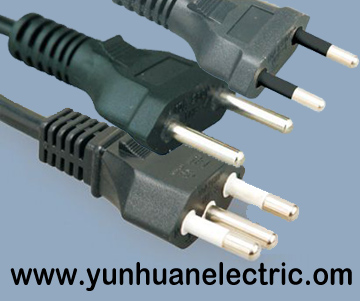




.jpg)
.jpg)
.jpg)
.jpg)
